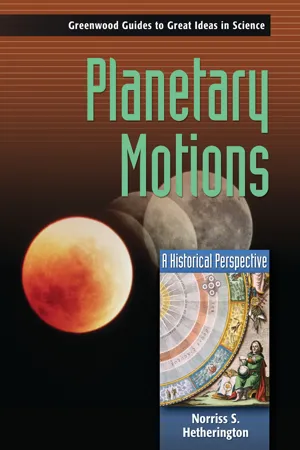
This is a test
- 248 pages
- English
- PDF
- Available on iOS & Android
eBook - PDF
Book details
Table of contents
Citations
About This Book
Students in an introductory physics class learn a variety of different, and seemingly unconnected, concepts. Gravity, the laws of motion, forces and fields, the mathematical nature of the science - all of these are ideas that play a central role in understanding physics. And one thing that connects all of these physical concepts is the impetus the great scientists of the past had to develop them - the desire to understand the motion of the planets of the solar system. This desire led to the revolutionary work of Copernicus and Galileo, Kepler and Newton. And their work forever altered how science is practiced and understood.
Frequently asked questions
At the moment all of our mobile-responsive ePub books are available to download via the app. Most of our PDFs are also available to download and we're working on making the final remaining ones downloadable now. Learn more here.
Both plans give you full access to the library and all of Perlego’s features. The only differences are the price and subscription period: With the annual plan you’ll save around 30% compared to 12 months on the monthly plan.
We are an online textbook subscription service, where you can get access to an entire online library for less than the price of a single book per month. With over 1 million books across 1000+ topics, we’ve got you covered! Learn more here.
Look out for the read-aloud symbol on your next book to see if you can listen to it. The read-aloud tool reads text aloud for you, highlighting the text as it is being read. You can pause it, speed it up and slow it down. Learn more here.
Yes, you can access Planetary Motions by Norriss S. Hetherington in PDF and/or ePUB format, as well as other popular books in Biological Sciences & Science General. We have over one million books available in our catalogue for you to explore.
Information
Table of contents
- CONTENTS
- Series Foreword
- Introduction
- List of Illustrations
- 1 An Introduction to the History of Science
- 2 Babylonian Planetary Astronomy
- 3 Plato and Saving the Appearances
- 4 Eudoxus and Concentric Spheres
- 5 Eccentrics and Epicycles
- 6 Equivalence
- 7 Astronomy and Physics
- 8 Saving the Phenomena Quantitatively
- 9 Ptolemy’s Exposition of Mathematical Astronomy
- 10 Reality or Mathematical Fiction?
- 11 The Greatest Astronomer of Antiquity or the Greatest Fraud in the History of Science?
- 12 Islamic Planetary Astronomy
- 13 Revival in the West
- 14 Copernicus and Planetary Motions
- 15 The Copernican Revolution
- 16 Breaking the Circle
- 17 Isaac Newton and Gravity
- 18 The Newtonian Revolution
- Timeline
- Glossary
- Annotated Bibliography
- Index
- Figure 4.1. The Sun in the Summer and Winter Skies.
- Figure 4.2. Modern Explanation for the Appearance of Retrograde Motion of a Planet.
- Figure 4.3. Retrograde Motion from Concentric Spheres.
- Figure 5.1. Eccentric and Epicycle Hypotheses.
- Figure 5.2. Eccentric Solar Orbit.
- Figure 5.3. Change of Distance in the Epicycle Hypothesis.
- Figure 5.4. Retrograde Motion in the Epicycle Hypothesis.
- Figure 8.1. Ptolemy’s Geometrical Demonstration of the Solar Eccentricity and Apogee.
- Figure 9.1. Ptolemy’s Lunar Theory.
- Figure 9.2. Opposition for Inferior Planets.
- Figure 9.3. Motion at Perigee and Apogee in the Eccentric and Epicycle Hypotheses.
- Figure 9.4. Equant Point.
- Figure 12.1. Straight Line Motion from Circular Motion.
- Figure 12.2. A page from al-Tusi’s Al-Tadhkira.
- Figure 12.3. Rotating Circles to Rectilinear Oscillations.
- Figure 13.1. Ptolemy and Regiomontanus are seated beneath an armillary sphere.
- Figure 13.2. Spherical Scheme of the Universe from Petrus Apianus, Cosmographicus Liber, 1540.
- Figure 14.1. Portrait of Copernicus.
- Figure 14.2. Copernicus’s Heliocentric Planetary Spheres, De revolutionibus, 1543.
- Figure 14.3. Orbit of an Inferior Planet in the Ptolemaic and Copernican Systems.
- Figure 14.4. Distances from the Earth of a Superior Planet at Conjunction and Opposition in the Ptolemaic and Copernican Systems.
- Figure 14.5 Parallax, Stellar Parallax, Distance.
- Figure 15.1. Leonard Digges, A prognostication everlasting, 1556.
- Figure 15.2. Thomas Digges, A Perfit Description of the Caelestial Orbes, 1576.
- Figure 15.3. Frontispiece, Galileo Galilei, Sidereus nuncius, 1610.
- Figure 15.4. Galileo’s drawing of the Moon, 1610.
- Figure 15.5. Galileo’s Discovery of Four Satellites of Jupiter.
- Figure 15.6. Phases of Venus in Ptolemaic and Copernican Models.
- Figure 15.7. Sunspot Drawing by Galileo, summer 1612.
- Figure 15.8. Frontispiece, Portrait of Galileo, The Assayer, 1623.
- Figure 15.9. Frontispiece, Dialogo di Galileo Galilei.
- Figure 16.1. The Great Quadrant at Augsburg.
- Figure 16.2. Tycho Brahe’s Nova Stella or New Star of 1572.
- Figure 16.3. Tycho Brahe’s Great Mural Quadrant at Uraniborg.
- Figure 16.4. The Tychonic World System.
- Figure 16.5. The Tychonic, Copernican, and Ptolemaic Systems Compared.
- Figure 16.6. Portrait of Tycho Brahe.
- Figure 16.7. Basic Polygons between Circular Orbits.
- Figure 16.8. The Five Regular Solids.
- Figure 16.9. Kepler’s Model of the Solar System; Close-up of the Model.
- Figure 16.10. Stars. Engraving by M. C. Escher.
- Figure 16.11. Ellipse.
- Figure 16.12. Kepler’s Law of Equal Areas.
- Figure 16.13. Kepler’s Music of the Spheres.
- Figure 16.14. Log—Log Plot of Orbital Period versus Distance from the Sun.
- Figure 17.1. Whirlpools of Matter. Descartes, Principia philosophiae, 1644.
- Figure 17.2. Shooting cannon balls on the Earth.
- Figure 17.3. The Moon in orbit around the Earth.
- Figure 17.4. Title page from the Principia, 1687.